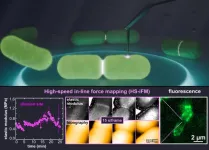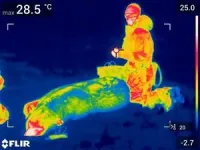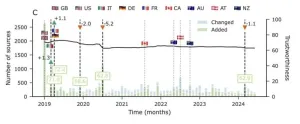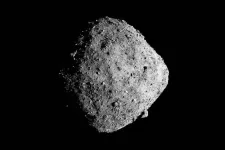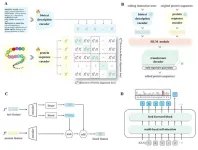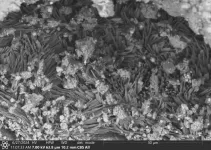(Press-News.org) Light and electron microscopy have distinct limitations. Light microscopy makes it difficult to resolve smaller and smaller features, and electron microscopy resolves small structures, but samples must be meticulously prepared, killing any live specimens.
Atomic force microscopy (AFM) is a technique originally developed to assess the physical and mechanical properties of materials at extremely high resolutions, but the imaging speeds aren’t fast enough (e.g. several minutes per frame) to capture relevant data for living biological samples. In contrast, another method, high-speed AFM (HS-AFM), is fast but cannot measure mechanical properties. Understanding the potential of this type of microscopy for the analysis of large molecules and microorganisms, researchers from the National Institutes of Natural Sciences (NINS) and Nagoya University created a new technique, high-speed in-line force mapping (HS-iFM), to acquire dynamic, mechanical force measurements at the speed and resolution required for living biological samples. The group – Christian Ganser, Shigetaka Nishiguchi, Feng-Yueh Chan, and Takayuki Uchihashi – chose the common bacteria Escherichia coli to study first in such unprecedented detail.
The researchers published their study in the January 29 issue of Science Advances.
“While it is clearly informative to study ‘static’ samples, [such as] bacteria that are not alive, observing the living organism allows us to directly follow changes in the course of [an organism’s] life, which becomes possible with our technique. Escherichia coli are great to demonstrate such effects because they are well studied. [D]espite th[is], the dynamic [mechanical] changes [that occur in E. coli at the] nanoscale level… remain elusive,” said Christian Ganser, assistant professor at the Exploratory Research Center on Life and Living Systems (ExCELLS) in the NINS in Okazaki, Japan.
During E. coli cell division, the researchers observed increased mechanical stiffening of the cell division site. The researchers hypothesize this stiffening could be due to localized membrane tension and local cell wall thickening. “[T]he division site becomes much stiffer than the surrounding cell, hinting at large internal stresses that are needed to deform the membrane and separate the cells,” said Ganser.
During division, the membrane also formed visible bridges between the two daughter cells that stretched and eventually broke. The creation and eventual breakage of these bridges lasted an average of 242 s ± 99 s (mean ± standard deviation) and was observed seven times. The entire division process is provided as a supplementary video in the online version of the research paper.
The team also observed a weak spot, less than 100 nm in diameter, in a dividing E. coli cell that ruptured, causing cell depressurization and death. Interestingly, the bursting cell caused depressurization of both left and right daughter cells, indicating that the cells were not completely separated internally. This observation suggests that HS-iFM may be useful in determining the timing of different steps during the division of E. coli and other bacteria.
HS-iFM allows researchers to measure both high resolution topography and membrane mechanical properties. During division of a living E. coli cell, the researchers observed visible membrane holes that close and reform again and diffuse across the membrane. The team hypothesized that these dynamic hole structures may be related to the formation of outer membrane vesicles, which are reported to be more frequent during cell division and around the new cell walls that develop between daughter cells during bacterial cell division. The pores could also be outer-membrane protein complexes located on the bacteria surface, but the measured pore diameter of 34.7 nm ± 11.8 nm (1 nm = 1 x 10-9 m) is significantly larger than previous reports of protein complex diameter, which is approximately 8 nm.
The research team acknowledges the great potential of the HS-iFM technique for studying a wide variety of biological samples and organisms, including E. coli. “In the [future], we will use our technique to study the dynamic and localized effect of external stimuli, [such as] antibiotics, to the nanomechanical properties of membranes of living bacteria,” said Ganser. The researchers also envision using HS-iFM to study the transient nanomechanical properties of polymers. Ideally, the team will increase the speed and resolution of the technique to visually capture the mechanical properties of molecules as small as individual proteins.
The co-authors of the research paper are Shigetaka Nishiguchi from the Exploratory Research Center on Life and Living Systems at the National Institutes of Natural Sciences in Okazaki, Japan; Feng-Yueh Chan from the Department of Physics at Nagoya University in Nagoya, Japan; and Takayuki Uchihashi from the Exploratory Research Center on Life and Living Systems at the National Institutes of Natural Sciences and the Department of Physics at Nagoya University.
This research was supported by JSPS KAKENHI Grant Number JP23H04874 in a Grant-in-Aid for Transformative Research Areas "Materials Science of Meso-Hierarchy” and 24K01309, 22K18943; by JST, CREST Grant Number JPMJCR21L2, Japan; and MEXT Promotion of Development of a Joint Usage/Research System Project: Coalition of Universities for Research Excellence Program (CURE) Grant Number JPMXP1323015482.
END
New microscopy technique reveals dynamic Escherichia coli membrane stiffness
2025-01-29
ELSE PRESS RELEASES FROM THIS DATE:
Bad hair bears! Greasy hair gives polar bears fur with anti-icing properties
2025-01-29
An international team of scientists has discovered the anti-icing secret of polar bear fur – something that allows one of the planet’s most iconic animals to survive and thrive in one of its most punishing climates. That secret? Greasy hair.
After some polar sleuthing, which involved scrutiny of hair collected from six polar bears in the wild, the scientists homed in on the hair “sebum” (or grease) as the all-important protectant. This sebum, which is made up of cholesterol, diacylglycerols, and fatty acids, makes it very hard for ice to attach to their fur.
While this finding ...
Materials can remember a sequence of events in an unexpected way
2025-01-29
UNIVERSITY PARK, Pa. — Many materials store information about what has happened to them in a sort of material memory, like wrinkles on a once crumpled piece of paper. Now, a team led by Penn State physicists has uncovered how, under specific conditions, some materials seemingly violate underlying mathematics to store memories about the sequence of previous deformations. According to the researchers, the method, described in a paper appearing today (Jan. 29) in the journal Science Advances, could inspire new ways to store information in ...
NewsGuard: Study finds no bias against conservative news outlets
2025-01-29
[Vienna, 29.01.2025]—A recent study evaluating the NewsGuard database, a leading media reliability rating service, has found no evidence supporting the allegation that NewsGuard is biased against conservative news outlets. Actually, the results suggest it’s unlikely that NewsGuard has an inherent bias in how it selects or rates right-leaning sources in the US, where trustworthiness is especially low.
“It seems unlikely that NewsGuard has an inherent bias against conservative sources, both in selecting and giving them lower ratings. Instead, the US media system is flooded with right-wing sources that tend to not adhere to professional ...
New tool can detect fast-spreading SARS-COV-2 variants before they take off
2025-01-29
By analysing millions of viral genome sequences from around the world, a team of scientists, led by the Peter Doherty Institute for Infection and Immunity (Doherty Institute) and the University of Pittsburgh, uncovered the specific mutations that give SARS-CoV-2 a ‘turbo boost’ in its ability to spread.
“Among thousands of SARS-CoV-2 mutations, we identified a small number that increase the virus’ ability to spread,” said Professor Matthew McKay, a Laboratory Head at the Doherty Institute and ARC Future Fellow in the Department of Electrical and Electronic Engineering at the University of Melbourne, and co-lead author of the ...
Berkeley Lab helps explore mysteries of Asteroid Bennu
2025-01-29
During the past year, there’s been an unusual set of samples at the Department of Energy’s Lawrence Berkeley National Laboratory (Berkeley Lab): material gathered from the 4.5-billion-year-old asteroid Bennu when it was roughly 200 million miles from Earth.
Berkeley Lab is one of more than 40 institutions investigating Bennu’s chemical makeup to better understand how our solar system and planets evolved. In a new study published today in the journal Nature, researchers found evidence that Bennu comes from an ancient wet world, with some material from the coldest regions of the solar system, likely beyond the orbit of ...
Princeton Chem discovers that common plastic pigment promotes depolymerization
2025-01-29
It turns out that the black plastic lid atop your coffee cup has a superpower. And the Stache Lab at Princeton Chemistry, which uncovered it, is exploiting that property to recycle at least two major types of plastic.
Their startling mechanism for promoting depolymerization relies on an additive that many plastics already contain: a pigment called carbon black that gives plastic its black color. Through a process called photothermal conversion, intense light is focused on plastic containing the pigment that jumpstarts the degradation.
So far, researchers have shown that carbon black can depolymerize polystyrene and polyvinyl chloride (PVC), two of the least recycled plastics in the planet’s ...
AI-driven multi-modal framework revolutionizes protein editing for scientific and medical breakthroughs
2025-01-29
Researchers from Zhejiang University and HKUST (Guangzhou) have developed a cutting-edge AI model, ProtET, that leverages multi-modal learning to enable controllable protein editing through text-based instructions. This innovative approach, published in Health Data Science, bridges the gap between biological language and protein sequence manipulation, enhancing functional protein design across domains like enzyme activity, stability, and antibody binding.
Proteins are the cornerstone of biological functions, and their precise modification holds immense potential for medical therapies, synthetic biology, and biotechnology. While traditional protein editing methods ...
Traces of ancient brine discovered on the asteroid Bennu contain minerals crucial to life
2025-01-29
A new analysis of samples from the asteroid Bennu, NASA’s first asteroid sample captured in space and delivered to Earth, reveals that evaporated water left a briny broth where salts and minerals allowed the elemental ingredients of life to intermingle and create more complex structures. The discovery suggests that extraterrestrial brines provided a crucial setting for the development of organic compounds.
In a paper published today, Jan. 29, in the journal Nature, scientists at the Smithsonian’s National Museum ...
Most mental health crisis services did not increase following 988 crisis hotline launch
2025-01-29
The launch of the nation’s 988 mental health hotline did not coincide with significant and equitable growth in the availability of most crisis services, except for a small increase in peer support services, according to a new RAND study.
Examining reports from thousands of mental health treatment facilities about the types of crisis services offered before and after the July 2022 rollout of the 988 hotline, researchers found that there was an increase in peer support services, a significant decrease in psychiatric walk-in services, and small declines in mobile crisis response and suicide prevention services.
Significant ...
D-CARE study finds no differences between dementia care approaches on patient behavioral symptoms or caregiver strain
2025-01-29
New research comparing different approaches to dementia care for people with Alzheimer’s disease and other dementias found no significant differences in patient behavioral symptoms or caregiver strain, whether delivered through a health system, provided by a community-based organization, or as usual care over an 18-month period.
However, the Dementia Care Study, also known as D-CARE, also found that caregiver self-efficacy—a measurement of caregivers’ confidence in managing dementia-related challenges and accessing support — improved in both the health-system and community-based ...
